ESP Abarth Grande Punto 2010 Owner handbook (in English)
[x] Cancel search | Manufacturer: ABARTH, Model Year: 2010, Model line: Grande Punto, Model: Abarth Grande Punto 2010Pages: 207, PDF Size: 3.01 MB
Page 113 of 207

111
WARNING
LIGHTS AND
MESSAGES
IN AN
EMERGENCY
CAR
MAINTENANCE
TECHNICAL
SPECIFICATIONS
INDEX
DASHBOARD
AND CONTROLS
SAFETY
DEVICES
CORRECT USE
OF THE CAR
STOPPING THE ENGINE
Turn the ignition to STOPwhile the en-
gine is idling.
IMPORTANT After a taxing drive, you
should allow the engine to “catch its
breath” before turning it off by letting it
idle to allow the temperature in the en-
gine compartment to fall.
A quick burst on the acceler-
ator before turning off the en-
gine serves absolutely no
practical purpose, it wastes
fuel and is damaging especially to tur-
bocharged engines.HOW TO WARM UP THE
ENGINE AFTER IT HAS JUST
STARTED
Proceed as follows:
❒ Drive off slowly, letting the engine turn
at medium revs. Do not accelerate
abruptly;
❒Do not drive at full performance for the
initial kilometres. Wait until the coolant
temperature gauge starts moving.
Remember that the servo-
brake and power steering are
not operational until the en-
gine has been started, there-
fore much effort than usual is required
on the brake pedal and steering wheel.
Never bump start the engine
by pushing, towing or coast-
ing downhill as this could
cause fuel to flow into the
catalytic exhaust system and damage
it beyond repair.
Page 116 of 207
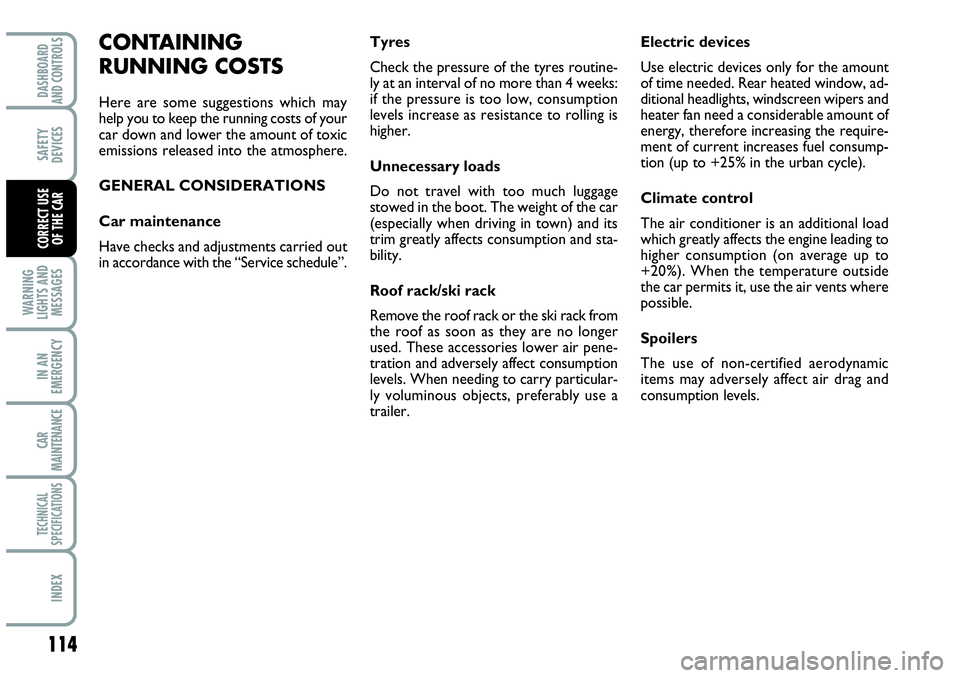
114
WARNING
LIGHTS AND
MESSAGES
IN AN
EMERGENCY
CAR
MAINTENANCE
TECHNICAL
SPECIFICATIONS
INDEX
DASHBOARD
AND CONTROLS
SAFETY
DEVICES
CORRECT USE
OF THE CAR
CONTAINING
RUNNING COSTS
Here are some suggestions which may
help you to keep the running costs of your
car down and lower the amount of toxic
emissions released into the atmosphere.
GENERAL CONSIDERATIONS
Car maintenance
Have checks and adjustments carried out
in accordance with the “Service schedule”.Tyres
Check the pressure of the tyres routine-
ly at an interval of no more than 4 weeks:
if the pressure is too low, consumption
levels increase as resistance to rolling is
higher.
Unnecessary loads
Do not travel with too much luggage
stowed in the boot. The weight of the car
(especially when driving in town) and its
trim greatly affects consumption and sta-
bility.
Roof rack/ski rack
Remove the roof rack or the ski rack from
the roof as soon as they are no longer
used. These accessories lower air pene-
tration and adversely affect consumption
levels. When needing to carry particular-
ly voluminous objects, preferably use a
trailer.Electric devices
Use electric devices only for the amount
of time needed. Rear heated window, ad-
ditional headlights, windscreen wipers and
heater fan need a considerable amount of
energy, therefore increasing the require-
ment of current increases fuel consump-
tion (up to +25% in the urban cycle).
Climate control
The air conditioner is an additional load
which greatly affects the engine leading to
higher consumption (on average up to
+20%). When the temperature outside
the car permits it, use the air vents where
possible.
Spoilers
The use of non-certified aerodynamic
items may adversely affect air drag and
consumption levels.
Page 123 of 207
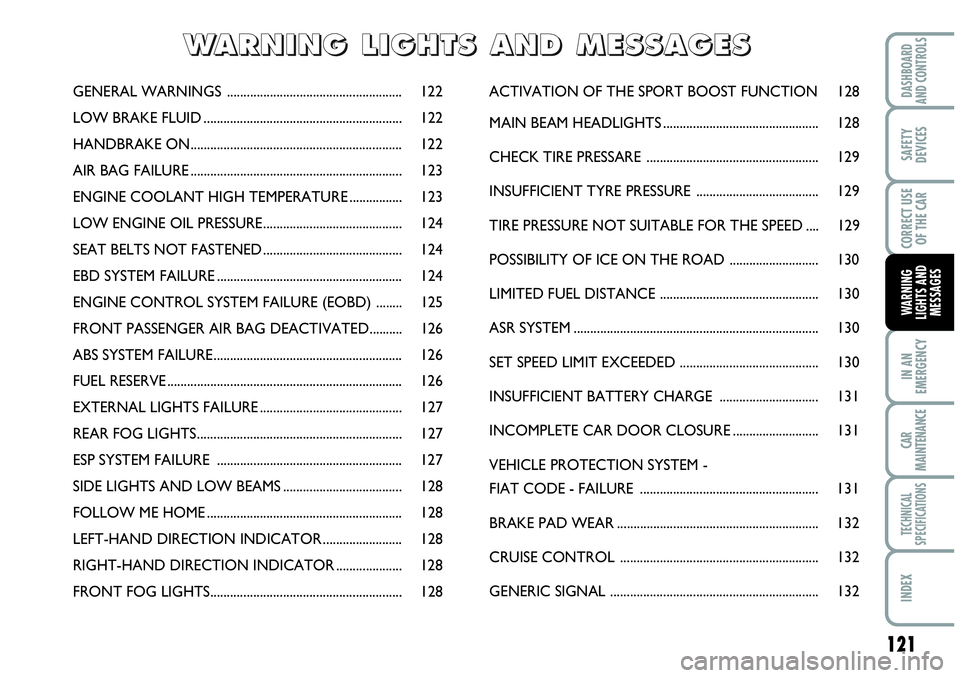
121
IN AN
EMERGENCY
CAR
MAINTENANCE
TECHNICAL
SPECIFICATIONS
INDEX
DASHBOARD
AND CONTROLS
SAFETY
DEVICES
CORRECT USE
OF THE CAR
WARNING
LIGHTS AND
MESSAGES
GENERAL WARNINGS ..................................................... 122
LOW BRAKE FLUID............................................................ 122
HANDBRAKE ON................................................................ 122
AIR BAG FAILURE ................................................................ 123
ENGINE COOLANT HIGH TEMPERATURE ................ 123
LOW ENGINE OIL PRESSURE.......................................... 124
SEAT BELTS NOT FASTENED .......................................... 124
EBD SYSTEM FAILURE ........................................................ 124
ENGINE CONTROL SYSTEM FAILURE (EOBD) ........ 125
FRONT PASSENGER AIR BAG DEACTIVATED.......... 126
ABS SYSTEM FAILURE......................................................... 126
FUEL RESERVE ....................................................................... 126
EXTERNAL LIGHTS FAILURE........................................... 127
REAR FOG LIGHTS.............................................................. 127
ESP SYSTEM FAILURE ........................................................ 127
SIDE LIGHTS AND LOW BEAMS.................................... 128
FOLLOW ME HOME ........................................................... 128
LEFT-HAND DIRECTION INDICATOR ........................ 128
RIGHT-HAND DIRECTION INDICATOR .................... 128
FRONT FOG LIGHTS.......................................................... 128ACTIVATION OF THE SPORT BOOST FUNCTION 128
MAIN BEAM HEADLIGHTS............................................... 128
CHECK TIRE PRESSARE .................................................... 129
INSUFFICIENT TYRE PRESSURE ..................................... 129
TIRE PRESSURE NOT SUITABLE FOR THE SPEED .... 129
POSSIBILITY OF ICE ON THE ROAD ........................... 130
LIMITED FUEL DISTANCE ................................................ 130
ASR SYSTEM.......................................................................... 130
SET SPEED LIMIT EXCEEDED .......................................... 130
INSUFFICIENT BATTERY CHARGE .............................. 131
INCOMPLETE CAR DOOR CLOSURE .......................... 131
VEHICLE PROTECTION SYSTEM -
FIAT CODE - FAILURE ...................................................... 131
BRAKE PAD WEAR ............................................................. 132
CRUISE CONTROL ............................................................ 132
GENERIC SIGNAL ............................................................... 132
W W
A A
R R
N N
I I
N N
G G
L L
I I
G G
H H
T T
S S
A A
N N
D D
M M
E E
S S
S S
A A
G G
E E
S S
Page 129 of 207

127
IN AN
EMERGENCY
CAR
MAINTENANCE
TECHNICAL
SPECIFICATIONS
INDEX
DASHBOARD
AND CONTROLS
SAFETY
DEVICES
CORRECT USE
OF THE CAR
WARNING
LIGHTS AND
MESSAGES
EXTERNAL LIGHTS
FAILURE (amber)
The warning light turns on
when problems are found in one
of the following headlamps:
– side lights
– rear fog lights
– directional indicators
– rear licence plate light
The problems regarding these lights may
be: one or more burnt bulbs, the burning
of the relative protection fuse or the in-
terruption of the electrical connections.
The display visualizes the specific message.
W
REAR FOG LIGHTS
(amber)
The light illuminates when the
rear fog lights are turned on.
4á
ESP SYSTEM FAILURE
(amber)
Turning the ignition key in the MARpo-
sition the warning light turns on, it has
to turn off after a few seconds.
If the light does not turn off, or if it is on
while driving together with the lighting of
the led on the ASR OFFbutton, refer to
the Abarth Dealership.
The display visualizes the specific message.
NB.The flashing of this light during car
motion indicates the insertion of the ESP
system.
The fixed illumination of the warning light
indicates a problem in the Hill-Holder sys-
tem. In this case refer to the Abarth Deal-
ership as soon as possible.
The display visualizes the specific message.
Page 139 of 207
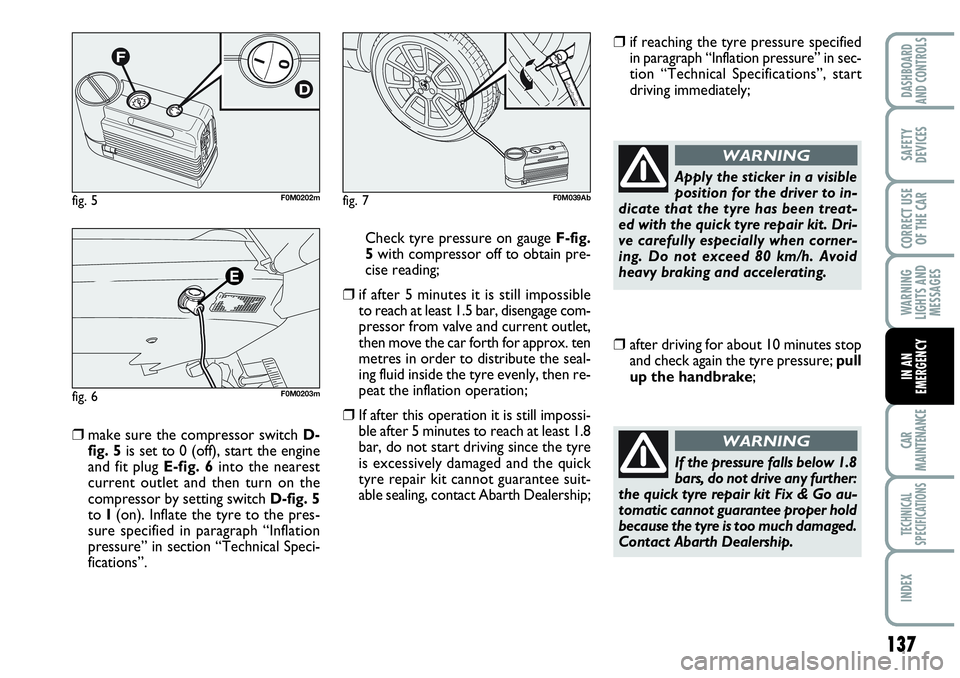
137
WARNING
LIGHTS AND
MESSAGES
CAR
MAINTENANCE
TECHNICAL
SPECIFICATIONS
INDEX
DASHBOARD
AND CONTROLS
SAFETY
DEVICES
CORRECT USE
OF THE CAR
IN AN
EMERGENCY
❒make sure the compressor switch D-
fig. 5is set to 0 (off), start the engine
and fit plug E-fig. 6into the nearest
current outlet and then turn on the
compressor by setting switch D-fig. 5
to I(on). Inflate the tyre to the pres-
sure specified in paragraph “Inflation
pressure” in section “Technical Speci-
fications”. Check tyre pressure on gauge F-fig.
5 with compressor off to obtain pre-
cise reading;
❒if after 5 minutes it is still impossible
to reach at least 1.5 bar, disengage com-
pressor from valve and current outlet,
then move the car forth for approx. ten
metres in order to distribute the seal-
ing fluid inside the tyre evenly, then re-
peat the inflation operation;
❒If after this operation it is still impossi-
ble after 5 minutes to reach at least 1.8
bar, do not start driving since the tyre
is excessively damaged and the quick
tyre repair kit cannot guarantee suit-
able sealing, contact Abarth Dealership;
❒if reaching the tyre pressure specified
in paragraph “Inflation pressure” in sec-
tion “Technical Specifications”, start
driving immediately;
Apply the sticker in a visible
position for the driver to in-
dicate that the tyre has been treat-
ed with the quick tyre repair kit. Dri-
ve carefully especially when corner-
ing. Do not exceed 80 km/h. Avoid
heavy braking and accelerating.
WARNING
❒after driving for about 10 minutes stop
and check again the tyre pressure; pull
up the handbrake;
If the pressure falls below 1.8
bars, do not drive any further:
the quick tyre repair kit Fix & Go au-
tomatic cannot guarantee proper hold
because the tyre is too much damaged.
Contact Abarth Dealership.
WARNING
fig. 5F0M0202m
fig. 6F0M0203m
fig. 7F0M039Ab
Page 141 of 207
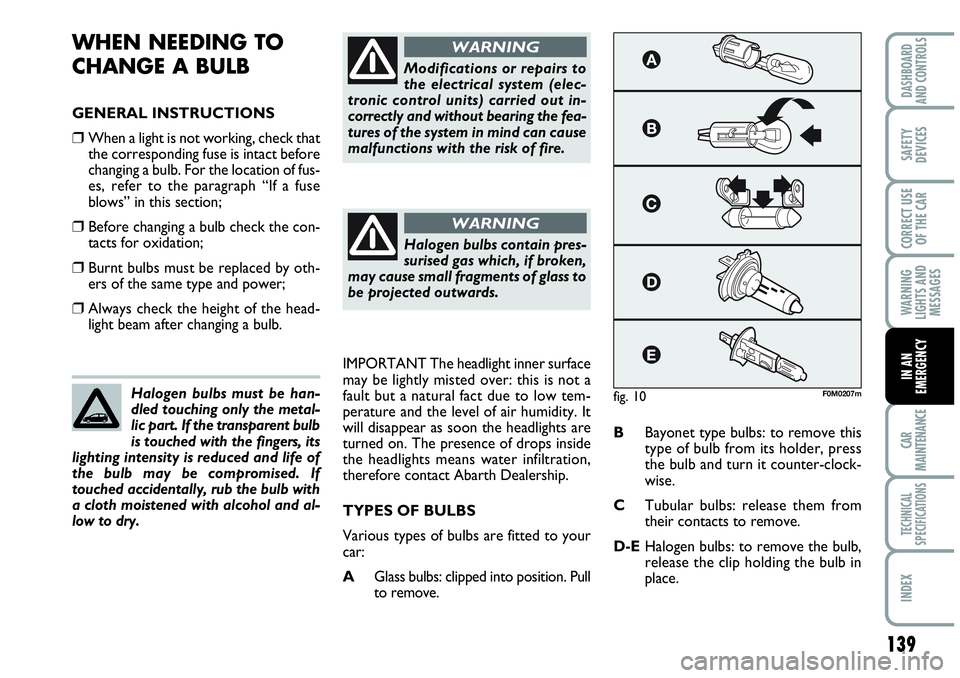
139
WARNING
LIGHTS AND
MESSAGES
CAR
MAINTENANCE
TECHNICAL
SPECIFICATIONS
INDEX
DASHBOARD
AND CONTROLS
SAFETY
DEVICES
CORRECT USE
OF THE CAR
IN AN
EMERGENCY
WHEN NEEDING TO
CHANGE A BULB
GENERAL INSTRUCTIONS
❒ When a light is not working, check that
the corresponding fuse is intact before
changing a bulb. For the location of fus-
es, refer to the paragraph “If a fuse
blows” in this section;
❒ Before changing a bulb check the con-
tacts for oxidation;
❒ Burnt bulbs must be replaced by oth-
ers of the same type and power;
❒ Always check the height of the head-
light beam after changing a bulb.
IMPORTANT The headlight inner surface
may be lightly misted over: this is not a
fault but a natural fact due to low tem-
perature and the level of air humidity. It
will disappear as soon the headlights are
turned on. The presence of drops inside
the headlights means water infiltration,
therefore contact Abarth Dealership.
TYPES OF BULBS
Various types of bulbs are fitted to your
car:
AGlass bulbs: clipped into position. Pull
to remove.BBayonet type bulbs: to remove this
type of bulb from its holder, press
the bulb and turn it counter-clock-
wise.
CTubular bulbs: release them from
their contacts to remove.
D-EHalogen bulbs: to remove the bulb,
release the clip holding the bulb in
place. Halogen bulbs must be han-
dled touching only the metal-
lic part. If the transparent bulb
is touched with the fingers, its
lighting intensity is reduced and life of
the bulb may be compromised. If
touched accidentally, rub the bulb with
a cloth moistened with alcohol and al-
low to dry.
Modifications or repairs to
the electrical system (elec-
tronic control units) carried out in-
correctly and without bearing the fea-
tures of the system in mind can cause
malfunctions with the risk of fire.
WARNING
Halogen bulbs contain pres-
surised gas which, if broken,
may cause small fragments of glass to
be projected outwards.
WARNING
fig. 10F0M0207m
Page 157 of 207

155
WARNING
LIGHTS AND
MESSAGES
CAR
MAINTENANCE
TECHNICAL
SPECIFICATIONS
INDEX
DASHBOARD
AND CONTROLS
SAFETY
DEVICES
CORRECT USE
OF THE CAR
IN AN
EMERGENCY
USERSFUSE AMPERE
ESP electric steering system control unit (+ignition power supply), NFR braking
system control unit (+ignition power supply), yaw sensor on tunnel
Left fog light, right fog light
Spare
Current socket (preparation)
Passenger compartment, cigar lighter current socket
Reversing light, relay coils on engine fuse junction unit
Defroster on driver’s door mirror, defroster on passenger side door mirror24
30
84
85
86
87
885
15
–
–
15
5
7.5
Page 166 of 207
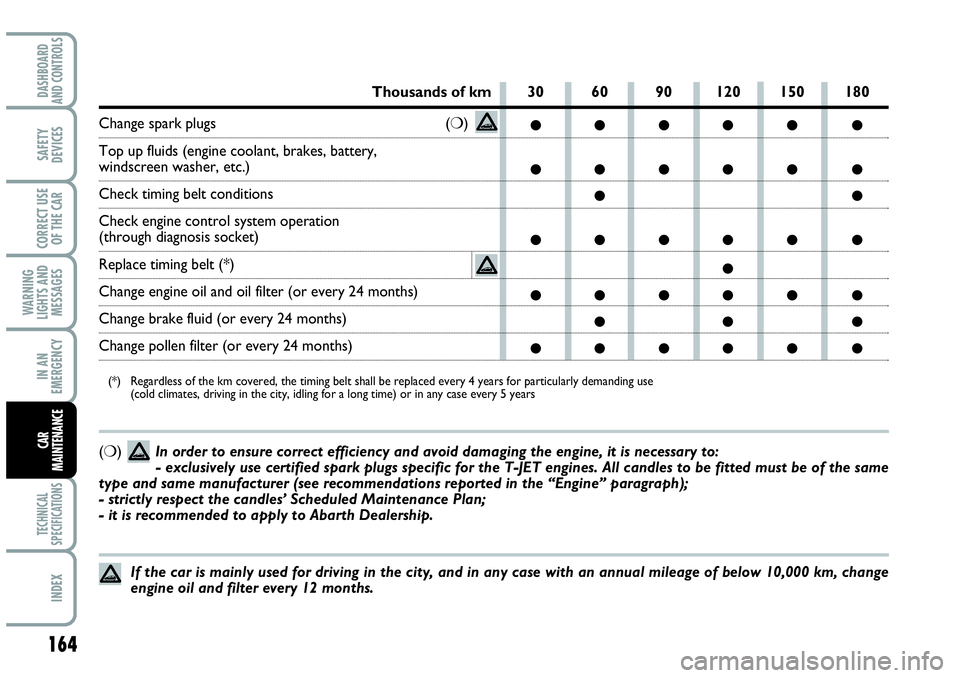
(❍) In order to ensure correct efficiency and avoid damaging the engine, it is necessary to:
- exclusively use certified spark plugs specific for the T-JET engines. All candles to be fitted must be of the same
type and same manufacturer (see recommendations reported in the “Engine” paragraph);
- strictly respect the candles’ Scheduled Maintenance Plan;
- it is recommended to apply to Abarth Dealership.
164
WARNING
LIGHTS AND
MESSAGES
TECHNICAL
SPECIFICATIONS
INDEX
DASHBOARD
AND CONTROLS
SAFETY
DEVICES
CORRECT USE
OF THE CAR
IN AN
EMERGENCY
CAR
MAINTENANCE
30 60 90 120 150 180
●●●●● ●
●●●●● ●
●●
●●●●● ●
●
●●●●● ●
●● ●
●●●●● ●
Thousands of km
Change spark plugs (❍)
Top up fluids (engine coolant, brakes, battery,
windscreen washer, etc.)
Check timing belt conditions
Check engine control system operation
(through diagnosis socket)
Replace timing belt (*)
Change engine oil and oil filter (or every 24 months)
Change brake fluid (or every 24 months)
Change pollen filter (or every 24 months)
(*) Regardless of the km covered, the timing belt shall be replaced every 4 years for particularly demanding use
(cold climates, driving in the city, idling for a long time) or in any case every 5 years
If the car is mainly used for driving in the city, and in any case with an annual mileage of below 10,000 km, change
engine oil and filter every 12 months.
Page 169 of 207
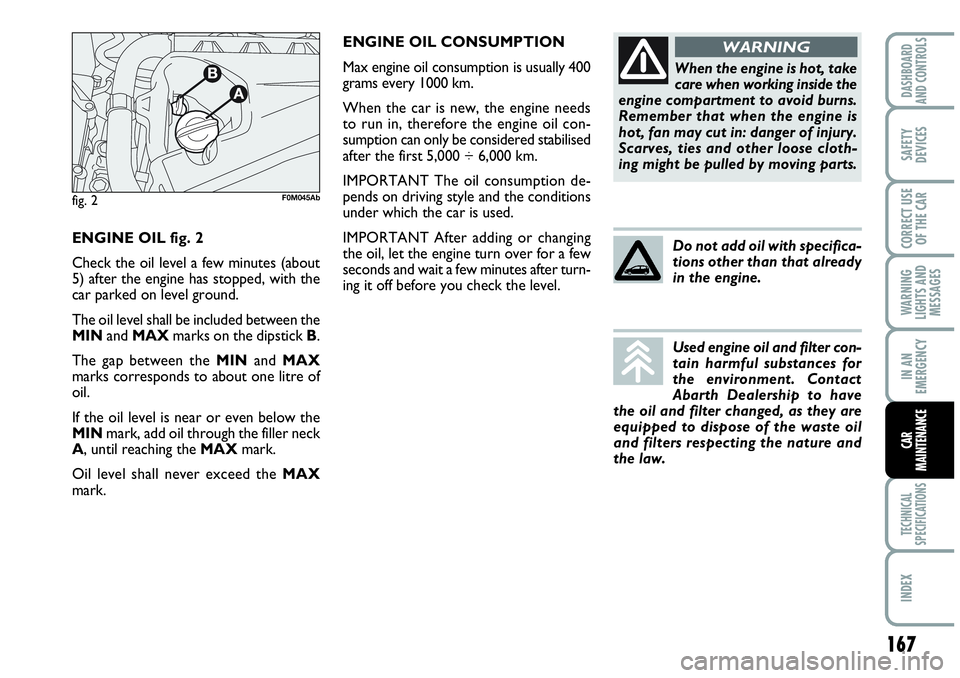
ENGINE OIL CONSUMPTION
Max engine oil consumption is usually 400
grams every 1000 km.
When the car is new, the engine needs
to run in, therefore the engine oil con-
sumption can only be considered stabilised
after the first 5,000 ÷ 6,000 km.
IMPORTANT The oil consumption de-
pends on driving style and the conditions
under which the car is used.
IMPORTANT After adding or changing
the oil, let the engine turn over for a few
seconds and wait a few minutes after turn-
ing it off before you check the level. ENGINE OIL fig. 2
Check the oil level a few minutes (about
5) after the engine has stopped, with the
car parked on level ground.
The oil level shall be included between the
MINand MAXmarks on the dipstick B.
The gap between the MINand MAX
marks corresponds to about one litre of
oil.
If the oil level is near or even below the
MINmark, add oil through the filler neck
A, until reaching the MAXmark.
Oil level shall never exceed the MAX
mark.
When the engine is hot, take
care when working inside the
engine compartment to avoid burns.
Remember that when the engine is
hot, fan may cut in: danger of injury.
Scarves, ties and other loose cloth-
ing might be pulled by moving parts.
WARNING
167
WARNING
LIGHTS AND
MESSAGES
TECHNICAL
SPECIFICATIONS
INDEX
DASHBOARD
AND CONTROLS
SAFETY
DEVICES
CORRECT USE
OF THE CAR
IN AN
EMERGENCY
CAR
MAINTENANCE
fig. 2F0M045Ab
Do not add oil with specifica-
tions other than that already
in the engine.
Used engine oil and filter con-
tain harmful substances for
the environment. Contact
Abarth Dealership to have
the oil and filter changed, as they are
equipped to dispose of the waste oil
and filters respecting the nature and
the law.
Page 185 of 207

CHASSIS MARKING fig. 3
It is printed on the passenger compart-
ment floor, near the right-hand front seat.
❒car model (ZFA 199000);
❒chassis number.ENGINE MARKING
Engine marking is stamped on the cylinder
block and includes the model and the
chassis number.
BODYWORK PAINT
IDENTIFICATION PLATE fig. 2
The plate is applied on the external tail-
gate post (left side) and it bears the fol-
lowing data:
APaint manufacturer.
BColour name.
CFiat colour code.
DRespray and touch up code.
fig. 2F0M0167mfig. 3F0M0168m
183
WARNING
LIGHTS AND
MESSAGES
INDEX
DASHBOARD
AND CONTROLS
SAFETY
DEVICES
CORRECT USE
OF THE CAR
IN AN
EMERGENCY
CAR
MAINTENANCE
TECHNICAL
SPECIFICATIONS